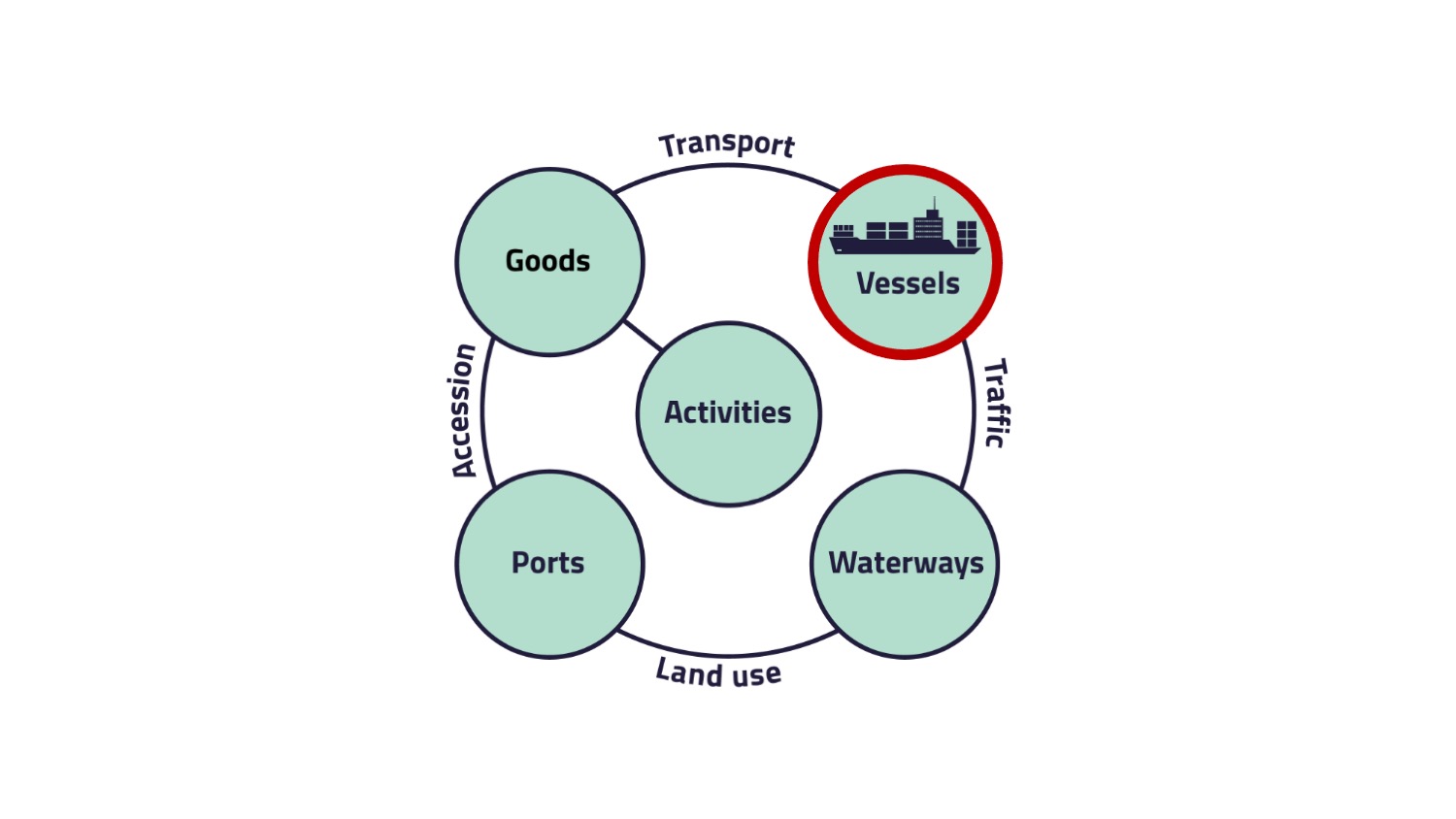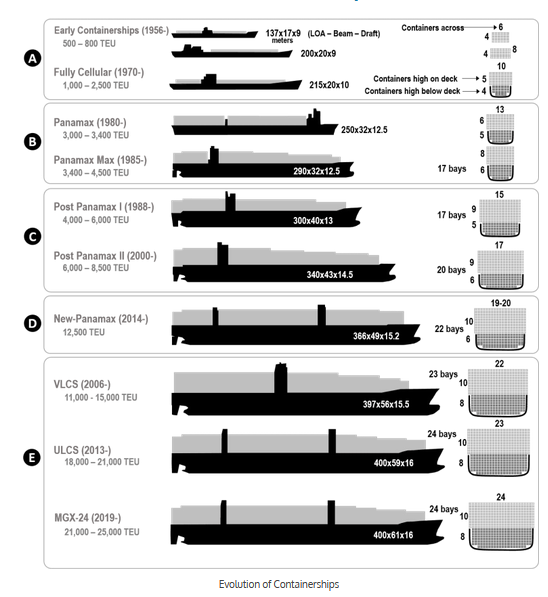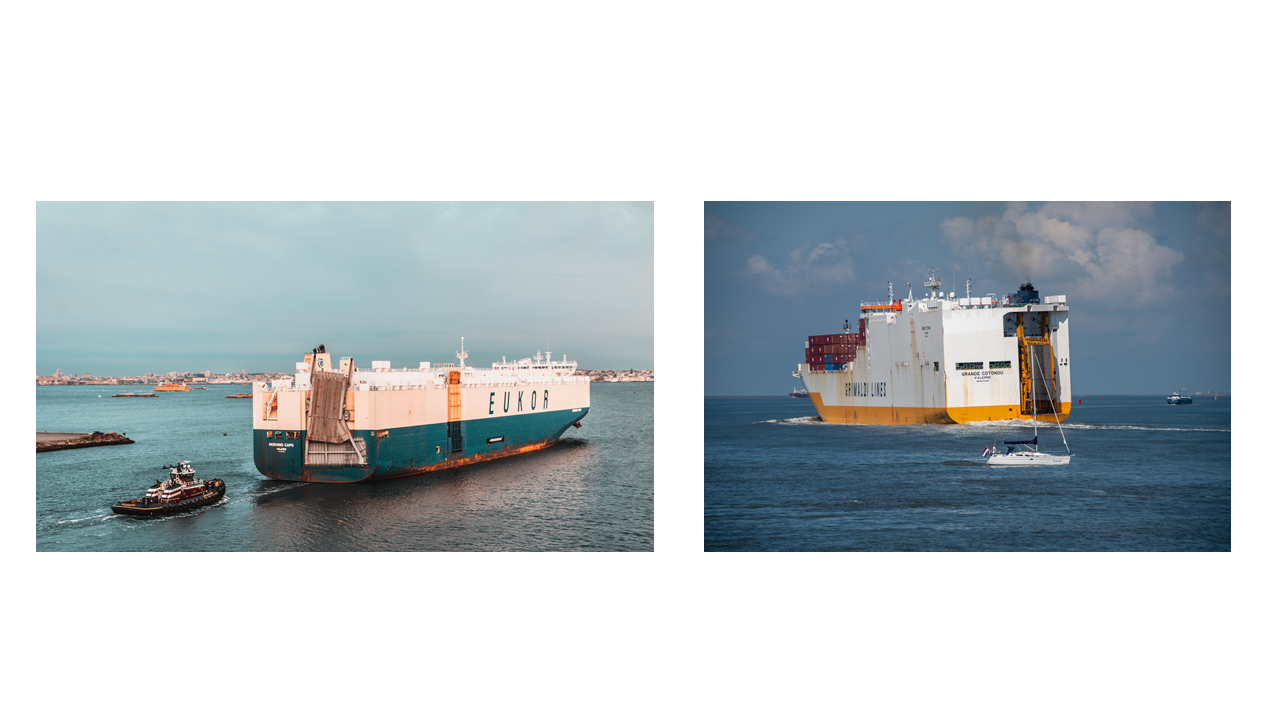Maritime Transport System
In this section you will learn more about maritime transport and its
elements: activities, goods, vessels, waterways and ports. As in the
last sections, this section follows the structure of the conceptual system model of transport and traffic.
4. Vessels
In the maritime transport system model, the movables are called "Vessels". These vessels are presented to you on this page.

The figure "Vessel types" shows a classification of different vessel types, that are used in maritime transport. Some of the vessels are presented to you in detail below.
1. Panamax Class
- capacity: < 4.500 TEU
- length: 250 m
- width: < 32,20 m
- depth: 12,5 m
2. Post Panamax Class
- capacity: > 4.000 TEU < 8.500 TEU
- length: 300 m
- width: > 32,20 m < 43 m
- depth: 13 m
Since the Expansion of the Panama Canal, ships up to a length of 366 m, a width of 49 m and a depth of 15,2 m can pass the canal. Those ships are called Neo Panamax Class.
3. Neo Panamax Class
- capacity: < 12.500 TEU
- length: 366 m
- width: < 49 m
- depth: 15,2 m
- capacity: < 15.000 TEU
- length: 397 m
- width: < 56 m
- depth: 15,5 m
- capacity: < 21.000 TEU
- length: 400 m
- width: < 59 m
- depth: 16 m
- capacity: > 21.000 TEU
- length: 400 m
- width: < 61 m
- depth: 16 m

Advantages of growth (Economies of Scale)
Cost of capital
- required engine power increases by 0,7 with more power
- less material needed for the surface of bigger spaces
- crew size independent from the size of the vessel (for a capacity bigger than 2.000 TEU)
- no correlation between administrative costs and vessel size
Bunker costs
- bunker costs are related to the engine power, thus relative costs are declining with increasing size.
Freight acquisition
- lower freight rates through economies of scale lead to strong market growth
Lay days in harbour
- bigger ships have to unload more containers at one location
- many ports are not equipped to handle those amounts efficiently
- limitations to the maximum draught
- efficiency of hinterland logistics
- liner services consist of 5-6 ships
- financing can become quite problematic, as this means investments of up to one billion € per service
Feeder costs
- increasing costs through additional handling operations
- longer travel times for the feeders through additional handling operations
Cost of insurance
The total costs of costs in port and costs at sea are presented in the figure "Relationship between costs and ship size".
Ro-Ro Vessels
Ro-Ro Vessels (Roll-on Roll-off) vessels are used for the transport of movable goods. Those goods like cars, trucks or trains can roll on and roll off the vessels on their own. With the help of tractors or swap bodies standardized loading units can be transported with this vessel type as well. Those ships have decks with adaptable heights, allowing a flexible usage of the loading space. The vessels have side, bow or stern hatches so that the movables can be driven on board via ramps.

Bulk Carrier
1. Handy Size Bulk Carrier
- capacity: up to 40.000 dwt (Deadweight tonnage)
- capacity: up to 45.000 dwt
3. Panamax Bulk Carrier
- capacity: up to 99.999 dwt
- width: < 32,20 m
4. Capesize Bulk Carrier
- capacity: over 100.000 dwt
1. Handysize Tanker
- capacity: 50.000 dwt
2. Panamax Tanker
- capacity: 65.000 – 80.000 dwt
3. Suezmax Tanker
- capacity: 120.000 - 180.000 dwt
4. Very Large Crude Carrier (VLCC)
- capacity: 200.000 – 320.000 dwt
5. Ultra Large Crude Carrier (ULCC)
- capacity: >320.000 dwt
Traffic
In order to save fuel and reduce emissions in maritime traffic, vessels are reducing their speed. As a rule of thumb, a ship’s engine load is related to the third power of its speed. Numerically, a 10% speed reduction results in a 27% engine load reduction.
The main maritime traffic routes and dimension of the traffic volume, which is visualized by the arrow thickness, are shown in the figure "Maritime traffic routes".
- port management system,
- systems dedicated to port security,
- support systems and management of pilotage,
- load management systems and overall property,
- docking planning,
- systems for collecting port taxes,
- quarantine control,
- customs control, and
- support for Coast Guard operations such as repression of illicit acts on ships, smuggling, drug trafficking, etc.
For maritime traffic it is necessary to use the waterways, which will be presented to you on the next page.
Literature
Faber, J.; Nelissen, D.; Hon, G.; Wang, H.; Tsimplis, M. (Hg.) (2012): Regulated Slow Steaming in Maritime Transport. An Assessment of Options, Costs and Benefits.
Flämig, H., Sjöstedt, L., Hertel, C. (2002): Multimodal Transport: An Integrated Element for Last-Mile-Solutions? Proceedings, part 1; International Congress on Freight Transport Automation and Multimodality: Organisational and Technological Innovations. Delft, 23 & 24 May 2002. (modification of Sjöstedt 1996)
Jansson, J. O.; Shneerson, D. (1987): Liner Shipping Economics. Dordrecht: Springer Netherlands.
Marvest GmbH (2021): Massengutfrachter. URL: https://www.marvest.de/magazin/schiffe/massengutfrachter/ (last access: 30.03.2022).
Rodrigue, J. (2020): The geography of transport systems. Fifth edition. London, New York: Routledge.
Schönknecht, A. (2009): Maritime Containerlogistik. Leistungsvergleich von Containerschiffen in intermodalen Transportketten. Berlin, Heidelberg: Springer Berlin Heidelberg (VDI-Buch).
Shelter Training Academy (2021): Vessel Traffic Management Information System (VTMIS). URL: https://sheltermar.com/vts/vtmis/ (last access: 30.03.2022).
Transway Internationale Spedition GmbH (2021): Informationen zu Schwergutfrachter. URL: https://spedition-seefracht.de/de/lexikon/schwergutfrachter (last access: 30.03.2022).
